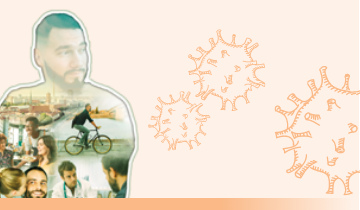
PBC is a chronic autoimmune liver disease in which the body’s own immune system mistakenly attacks the cells of the bile ducts, causing inflammation. As a result, bile drainage becomes impaired, leading to bile stasis (cholestasis). The ongoing inflammation progressively scars the bile ducts—a process also known as fibrosis. If fibrosis advances, it can result in liver cirrhosis or even liver failure.1 Without treatment, more than half of patients develop liver cirrhosis within four years.2
Read more about how liver cirrhosis can develop and its consequences.
The persistent chronic inflammation leads to damaged bile duct cells and their subsequent loss.3 Early diagnosis and targeted treatment are therefore particularly important in order to slow down the progression of the disease and to improve the quality of life of those affected.
PBC is most commonly diagnosed in people between the ages of 40 and 60. It can affect anyone, regardless of gender or ethnicity. However, it is remarkable that women are approximately four to six times more likely to develop PBC than men.4 In Germany, approximately 37 out of every 100,000 people are affected by PBC.5
The exact cause of PBC remains unclear and is the focus of ongoing research. Experts believe that a combination of genetic predisposition and environmental factors—such as smoking, existing urinary tract infections and/or a lack of diversity in the intestinal flora—plays a role in its development.6 The immune system gets out of balance and attacks the body’s own cells in the bile ducts, leading to a chronic inflammatory reaction.6 People with autoimmune diseases (e.g., Hashimoto’s thyroiditis) also have an increased risk of developing PBC. Conversely, people with PBC are also more likely to develop other autoimmune diseases.12
The symptoms of PBC vary from person to person.7 Initially, the disease is often asymptomatic, but as it progresses, many patients develop symptoms.7,8 The most common ones—severe itching and chronic exhaustion (fatigue)—can significantly impact quality of life.9,10 Learn more about how you can cope better with it in the tab “Itching and Fatigue”.
Fatty stools and deficiency symptoms
As the disease progresses, patients may experience impaired absorption of fat-soluble vitamins, which can lead to deficiencies and fatty stools.7
Symptoms associated with progressive liver damage
As liver damage progresses, jaundice may develop, along with typical symptoms of liver cirrhosis, such as internal bleeding or fluid accumulation in the abdomen (ascites).11
Other possible symptoms
Other possible symptoms may include lower abdominal pain, darker skin pigmentation and the appearance of small, yellowish or white skin nodules.11
Extrahepatic manifestations
Extrahepatic manifestations are clinical presentations that do not directly affect the liver but are associated with a liver disease such as PBC. Up to 73% of patients experience these manifestations, which commonly include Sjögren’s syndrome, thyroid dysfunction and systemic sclerosis.12
Sjögren’s syndrome
Sjögren’s syndrome is an autoimmune disease in which the immune system mistakenly attacks the lacrimal and salivary glands, resulting in dry eyes and dry mouth. Women may also experience vaginal dryness. In rarer cases, joint pain, vascular inflammation or kidney inflammation can also occur.12,13
Thyroid dysfunction
Thyroid dysfunction is a common comorbidity in PBC, typically manifesting as hypothyroidism or, less frequently, hyperthyroidism. Many PBC patients develop Hashimoto’s thyroiditis, an autoimmune condition that leads to hypothyroidism, while Graves’ disease, which causes hyperthyroidism, is less common.12
Systemic sclerosis
Systemic sclerosis is an autoimmune disease that affects the connective tissue in the skin and organs, causing hardening and scarring (fibrosis). Its symptoms vary widely and can include skin changes, digestive issues, as well as heart and kidney complications.12
Itching (pruritus)
Approximately 20–80% of PBC patients suffer from itching, typically affecting the palms of the hands and soles of the feet.6,9 Intense itching can lead to sleep disturbances and concentration problems, especially if it is more intense, and can contribute to low self-esteem.10 Using special moisturizers and soothing skincare products may help, as well as taking cool showers to counteract heat-induced itching at night. Psychological support can also be beneficial in managing compulsive scratching, and testing for possible allergies may provide additional insights.1
Chronic exhaustion (fatigue) and cognitive impairment
Many PBC patients suffer from fatigue8—a persistent physical and mental exhaustion that is not easily relieved, even with adequate rest. Fatigue is often accompanied by cognitive issues, such as concentration and memory problems. To improve or alleviate fatigue, experts recommend first identifying and addressing any underlying causes, such as anemia, hypothyroidism or sleep disorders.1 Additionally, patients can develop coping strategies, like avoiding social isolation, which can further worsen fatigue.1
Unfortunately, fatigue is a challenging symptom to manage and can also be associated with episodes of itching. In these cases, treatment of the itching can also have a positive effect on fatigue.9
In its early, asymptomatic stages, PBC is usually discovered incidentally—typically during routine blood tests that reveal elevated liver values.11 The diagnosis primarily relies on the analysis of certain laboratory parameters, complemented by a thorough medical history and, if necessary, a tissue biopsy. PBC is diagnosed when at least two of the following three criteria are met:1,14
Although PBC cannot be cured, it can be treated. In some cases, optimized therapy can normalize the liver values and thus prevent the progression of the disease. The normalization of liver values is therefore a key therapeutic goal and can be a decisive indicator for the long-term success of treatment. Alkaline phosphatase (ALP) and bilirubin levels are particularly important and should be monitored regularly.15
In many patients, standard PBC therapy is effective and leads to a significant reduction in liver values. Nevertheless, more than a third of patients do not respond adequately to the standard therapy and therefore remain undertreated.16 For these patient groups, alternative second-line therapies can be considered, which can be used either in combination with the standard therapy or as a single therapy.1 Some PBC therapies not only target the underlying disease but also effectively alleviate itching. As already mentioned, successful managing itching can potentially have a positive effect on fatigue.17
In order to check whether the treatment of PBC is effective or whether the disease is progressing, regular follow-up checks are essential. Important liver values are measured:1,18
In the first year after diagnosis, these values should be checked after three, six and 12 months to determine whether the treatment is successful or needs to be adjusted. The follow-up checks should be continued beyond the first year, whereby the time intervals should be individually adapted to the patient.18
As mentioned in “Therapy”, the normalization of liver values is an important therapeutic goal.
It is therefore essential to discuss your blood values and treatment progress with your doctor regularly. If the therapy is not as effective as expected, a referral to a specialist practice or liver outpatient clinic should be considered if this has not already been made. Personalized treatment gives you the best chance to manage the disease effectively and alleviate symptoms. Don’t hesitate to ask questions and work closely with your doctor to find the most suitable treatment options.

What actually is hepatitis C? Here you will find useful explanations.

Find out more about hepatitis D! What makes it different from hepatitis B? And how can you protect yourself?

Would you like to know more about the liver and what it does? Then you've come to the right place.